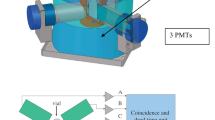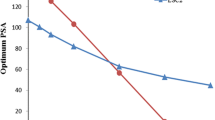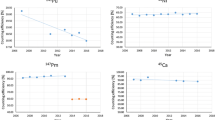Abstract
Liquid scintillation counting (LSC) supports a range of environmental science measurements. At Pacific Northwest National Laboratory, we are constructing an LSC system with an expected background reduction of 10–100 relative to values reported in the literature. In this paper, a number of current measurement applications of LSC have been considered with an emphasis on determining which aspects of such measurements would gain the greatest benefit: improved minimum detectable activity (MDA), reduction in sample size, and reduction in total analysis time.
Similar content being viewed by others
References
L’Annuziata M (2012) Handbook of radioactivity analysis, 3rd edn. Academic Press, Chapters 7–9, San Diego
Plastino W, Chereji I, Cuna S, Kaihola L, De Felice P, Lupsa N, Balas G, Mirel V, Berdea P, Baciu C (2007) Tritium in water electrolytic enrichment and liquid scintillation counting. Radiat Meas 42:68–73
Vaupotič J, Ogrinc N, Brenčič M, Kobal I (2011) Tritium mapping in spring waters in Slovenia. Geochem J 45:505–512
Aalseth CE, Bonicalzi RM, Cantaloub MG, Day AR, Erikson LE, Fast JE, Forrester JB, Fuller ES, Glasgow BD, Greenwood LR, Hoppe EW, Hossbach TW, Hyronimus BJ, Keillor ME, Mace EK, McIntyre JI, Merriman JH, Myers AW, Overman CT, Overman NR, Panisko ME, Seifert A, Warren GA, Runkle RC (2012) A shallow underground laboratory for low-background radiation measurements and materials development. Rev Sci Instrum 83(11):113503
Runkle RC, Aalseth CE, Bailey VL, Bonicalzi R, Moran JJ, Seifert A, Warren GA (2012) Opportunities for decay counting of environmental radioisotopes using ultra-low-background detection systems. PNNL-21709. Pacific Northwest National Laboratory, Richland
Keillor ME, Aalseth CE, Day AR, Erikson LE, Fast JE, Glasgow BD, Hoppe EW, Hossbach TW, Hyronimus BJ, Miley HS, Myers AW, Seifert A, Stavenger TJ (2011) CASCADES: an ultra-low-background germanium crystal array at Pacific Northwest national laboratory. AIP Conf Proc 1412:208–215
Aalseth CE, Day AR, Hoppe EW, Hossbach TW, Hyronimus BJ, Keillor ME, Litke KE, Mintzer EE, Seifert A, Warren GA (2009) Design and construction of a low-background, internal-source proportional counter. J Radioanal Nucl Ch 282(1):233–237
Erchinger JL, Aalseth CE, Beacham TA, Bernacki BE, Douglas M, Fuller ES, Keillor ME, Morley SM, Mullen CA, Orrell JL, Panisko ME, Shaff SM, Warren GA, Williams RO, Wright ME (2015) Development of a low background liquid scintillation counter for a shallow underground laboratory. Appl Radiat Isot. doi:10.1016/j.apradiso.2015.08.027
Currie LA (1968) Limits for qualitative detection and quantitative determination: application to radiochemistry. Anal Chem 40(3):586–593
Kern Z, Molnár M, Svingor E, Persoiu A, Nagy B (2009) High resolution, well-preserved tritium record in the ice of Bortig Ice Cave, Bihor Mountains, Romania. Holocene 19:729–736
Janovics R, Bihari Á, Papp L, Dezső Z, Major Z, Sárkány KE, Bujtás T, Veres M, Palcsu L (2014) Monitoring of tritium, 60Co and 137Cs in the vicinity of the warm water outlet of The Paks Nuclear Power Plant, Hungary. J Environ Radioactiv 128:20–26
Nikolov J, Todorovic N, Jankovic M, Vostinar M, Bikit I, Veskovic M (2013) Different methods for tritium determination in surface water by LSC. Appl Radiat Isot 71:51–56
Koarashi JM, Nakada S (2008) A Monitoring methodologies and chronology of radioactive airborne releases from Tokai reprocessing plant. J Nucl Sci Technol 5:462–465
Matsuura K, Sasa Y, Nakamura C, Katagiri H (1995) Levels of tritium concentration in the environmental samples around JAERI Tokai. J Radioanal Nucl Ch 197(2):295–307
Morgenstern U, Taylor CB (2009) Ultra low-level tritium measurement using electrolytic enrichment and LSC. Isot Environ Healt S 45(2):96–117
Rank D (1993) Environmental tritium in hydrology: present state 1992. In: Noakes JE, Schonhofer F, Polach HA (eds) Advances in liquid scintillation spectrometry. Radiocarbon Publishers, University of Arizona, Tucson, pp 327–334
Kim SB, Stuart M (2013) An alternative method of OBT measurement for the limited quantity of environmental samples using a combustion bomb. Appl Radiat Isot 82:175–180
Pointurier F, Baglan N, Alanic G, Chappini R (2004) A method for the determination of low-level organic-bound tritium activities in environmental samples. Appl Radiat Isot 61:293–298
Hardy EP Jr (1977) Final tabulation of monthly 90Sr Fallout data: 1954–1976, health and safety laboratory report. HASL-329, U.S. Energy Research and Development Administration, New York
Lopes I, Madruga MJ (2008) Application of liquid scintillation counting technique to the determination of 90Sr in milk samples. In: J Eikenberg, M Jäggi, H Beer, H Baehrle (eds) Advances in liquid scintillation spectrometry. © 2009 by the Arizona Board of Regents on behalf of the University of Arizona; LSC 2008, pp. 331–337
Oikawa STH, Watabe T, Misonoo J, Kusakabe M (2013) Distribution of the Fukushima-derived radionuclides in seawater in the Pacific off the coast of Miyagi, Fukushima, and Ibaraki Prefectures, Japan. Biogeosciences 10:5031–5047
Lee MHCK, Choi GK, Lee CW (2002) Measurement of 90Sr in aqueous samples using liquid scintillation counting with full spectrum DPM method. Appl Radiat Isot 57:257–263
Wang JJ (2013) A quick liquid scintillation counting technique for analysis of 90Sr in environmental samples. Appl Radiat Isot 81:169–174
Takagai YFM, Kameo Y, Suzuki K (2014) Sequential inductively coupled plasma quadrupole mass-spectrometric quantification of radioactive strontium-90 incorporating cascade separation steps for radioactive contamination rapid survey. Anal Methods 6:355–362
Vogl K, Gesewsky P (1992) A rapid method for the determining 89Sr and 90Sr from nuclear accidents. In liquid scintillation spectrometry, p 435–438
Kim CK, Al-Hamwi A, Törvényi A, Kis-Benedek G, Sansone U (2009) Validation of rapid methods for the determination of radiostrontium in milk. Appl Radiat Isot 67:786–793
Torres JMLM, Rauret G, Bickel M, Altzitzoglou T, Pilviö R (2000) Determination of 90Sr in aquatic organisms by extraction chromatography: method validation. Anal Chim Acta 414:101–111
Maxwell SL, Culligan BK (2009) Rapid method for determination of radiostrontium in emergency milk samples. J Radioanal Nucl Chem 279(3):757–760
Heilgeist M (2000) Use of extraction chromatography, ion chromatography and liquid scintillation spectrometry for rapid determination of strontium-89 and strontium-90 in food in cases of increased release of radionuclides. J Radioanal Nucl Chem 245(2):249–254
Gale SJ (2009) Dating the recent past. Quat Geochronol 4:374–377
Geibert W, Van der Loeff MMR, Hanfland C (2002) Dauelsberg H-J Actinium-227 as a deep-sea tracer: sources, distributions, and applications. Earth Planet Sci Lett 198:147–165
Nozaki Y (1984) Excess 227Ac in deep ocean water. Nature 310:486–488
Cabell MJ (1959) The purification, determination, and neutron capture cross-section of Actinium-227. Can J Chem 37:1094–1103
Percival DR, Martin DB (1974) Sequential determination of Radium-226, Radium-228, Actinium-227, and Thorium isotopes in environmental and process waste samples. Anal Chem 46(12):1742–1749
Geibert W, Vöge I (2008) Progress in determination of 227Ac in sea water. Mar Chem 109:238–249
Acknowledgements
The authors gratefully acknowledge support for this work from the Ultra-Sensitive Nuclear Measurements Initiative, a Laboratory Directed Research and Development Initiative at Pacific Northwest National Laboratory. We thank Deb Barnett for assistance with editing and finalizing this manuscript for publication.
Author information
Authors and Affiliations
Corresponding author
Rights and permissions
About this article
Cite this article
Douglas, M., Bernacki, B.E., Erchinger, J.L. et al. Liquid scintillation counting of environmental radionuclides: a review of the impact of background reduction. J Radioanal Nucl Chem 307, 2495–2504 (2016). https://doi.org/10.1007/s10967-015-4512-8
Received:
Published:
Issue Date:
DOI: https://doi.org/10.1007/s10967-015-4512-8




